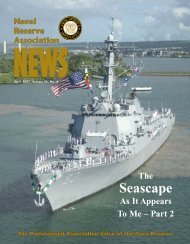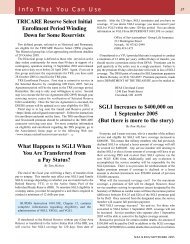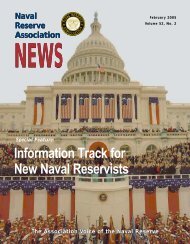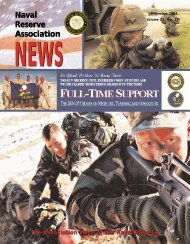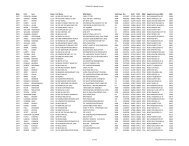Naval Reserve Association
Naval Reserve Association
Naval Reserve Association
You also want an ePaper? Increase the reach of your titles
YUMPU automatically turns print PDFs into web optimized ePapers that Google loves.
Legislative Update7Effects of 2005 BRAC RecommendationsBy CAPT Ike Puzon, USNR (Ret), Director of LegislationOur July 2005 issue covered the BRACrecommendations relevant to Navy<strong>Reserve</strong>. The effects of 2005 BRAC onall military stakeholders will be vast. NRAhopes that we never forget that our great countryis at war. Military members and their familiesare asked to sacrifice and, in some cases, pay theultimate price for service to our country. In thistime of change and war, something writtenabout in many historical documents, we haveto refocus on what it means to enjoy what wehave and what we are asking of the militarymembers.Active, Guard, <strong>Reserve</strong>, civilian personnel,retired personnel plus their families andsurvivors will feel the weight of theseBRAC 2005 recommendations that will goforward this month to the President and then onto Congress for approval. Many of the effectedsites have sizeable military populations of thesestakeholders. These people answered the callfor service and made important decisions abouttheir lives and our country. Service to theircountry was a factor that should, and must notever, be taken lightly. Current recruitment andretention shortages of today are proof of howserious we all should take a person’s decision toserve in the military in one form or the other.The loss of bases, military treatment facilities,commissaries and MWR programs, or availabilityjust to serve (in the case of <strong>Reserve</strong> or Guardmembers) can and will cause a huge financialas well as mental strain on those who havealready chosen to serve. No doubt these closureswill affect recruitment and retention. Manyof our young people are watching these trendsclosely.The recent GAO report, Military Bases:Analysis of DoD’s 2005 Selection Processand Recommendations for Base Closure andRealignments (GAO-05-785), pointed outseveral concerns about the process and selectionprocess of this round of recommendations,. Throughout this GAO reviewand almost all of the BRAC hearings, there isa constant theme that is echoed. Perhapsassumptions were made by the services andDoD in presenting the current BRAC 2005recommendations. However, the larger issue isthat support groups were not included in thereview process to ensure availability and capacityof DoD facilities. Reviewing the deliberationsdata and hearing testimonies, inappropriateassumptions and failure of a complete detailedanalysis were used in evaluation of manpowerrequirements for current and future capabilities.Several BRAC members have stated this, as wellas defendants of facilities on the list to close orrealign.Considering health care, the recommendationsassumed support from outside groups. However,Department of VA, managed care supportcontractors, and beneficiary advocacy groupswere not included in the process. It appears thata rethinking of MTF capabilities and requirementswill have to be completed. If re-basing andBRAC recommendations are completed, willthe shift in care go to civilian networks – thus,increasing the cost to DoD, the services, andultimately the beneficiary? It should be a concernto all that non-DoD medical resources may notbe able to meet the increases in demand, since,in some places, they cannot or will not meet thedemand at this time. Degradation of benefitsshould not occur to the individual beneficiary.Quality of life issues have been a constantconcern for improvement since the end of theCold War. These are a struggle to achieve. It isclear that for retirees and survivors, Guard and<strong>Reserve</strong> populations were not considered inrecommendations about keeping commissaries,exchanges, or MWR facilities open. Withtransformation going on, returning servicemembers from overseas, base closures, andreturning military combatant forces (which doinclude Guard and <strong>Reserve</strong>), existing quality oflife facilities and QoL programs will bestretched. It is clear that neither DoD nor theservices thought about these populations inmaking current recommendations. Plans andbenefits for QoL programs should be in placeprior to utilization of these issues. Since 1991,Defense Commissary Agency (DeCA) reportsthat there have been 43 BRAC-related commissaryclosures. The current BRAC recommendationswill place more pressure on DeCA and this veryimportant QoL benefit.The massive changes in Guard and <strong>Reserve</strong>forces is now going to be affected even morewith the BRAC 2005 recommendations –especially in the Navy and Air Force downsizing.The recommendations overlooked or undervaluedimpact on operational readiness including thetop priority of joint warfighting capabilities,strategic location of Guard and <strong>Reserve</strong> facilitieswith respect to Defense and Homeland Securityconcerns, end strength, training, demographicand skill sets. In most cases, the Guard and<strong>Reserve</strong> manpower (especially <strong>Naval</strong> <strong>Reserve</strong>)was not even considered in the data analysis.There is no doubt that joint capabilities ofGuard and <strong>Reserve</strong> forces were overlookedsince none of the questions asked of the forcesincluded joint questions. Additionally, the JointService Groups that evaluated <strong>Naval</strong> <strong>Reserve</strong>facilities did not consider cross-service data.They only considered, in the case of the Navy,Navy service-specific data.Recruiting and retention of Guard and<strong>Reserve</strong> forces were not considered. The best wayto describe Navy and AF Guard recommendationsis: trained manpower was not a factor in closingor realignment of these facilities. The costanalysis data clearly show that the manpowerwas not a factor. <strong>Reserve</strong> members and Guardmembers are going to be expected to commutefurther on their own to serve their country orservice. In the Navy’s case, there will be noopportunity for skilled, trained veterans to servein the Navy. We are using the Guard and<strong>Reserve</strong> Components more and more, yetproviding less opportunity for them to serve.Coordination of the current BRAC 2005recommendation was not done. The Departmentof VA, Department of Homeland Security,Coast Guard, and Department of Health andHuman Services were not consulted. And, aswe know now, the Governors of several stateswere not consulted. The experienced combattestedmanpower was not considered. Overall,a fair analysis does not seem to be the format.Generally, active duty constructs were appliedto all actions.So what is the next step? Legally, the BRAC2005 recommendations go to the Presidenton 8 September 2005. Then, they go to theCongress. Hopefully, you will let your opinionbe known on these recommendations. Thereare several ways to reach out on theserecommendations. You can have a personalinput on the BRAC Web site .Additionally, you could let Congress knowyour thoughts by e-mail to your senator, and your representatives. I also suggest,e-mail the White House .The effects of the BRAC 2005 recommendationsare more than a major issue, so consider makingyour opinion known.NRA NEWS/SEPTEMBER 2005










